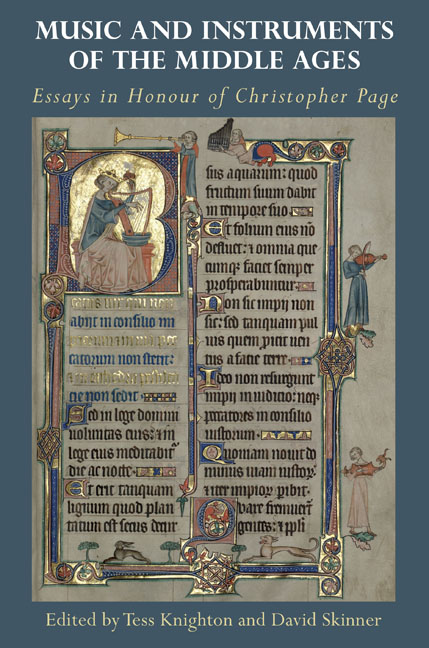Book contents
- Frontmatter
- Contents
- List of Illustrations
- List of Music Examples
- List of Tables
- List of Contributors
- List of Music Manuscript Sigla
- Acknowledgements
- Introduction
- SONGSTERS AND THEIR REPERTORIES
- CLOSE READINGS
- CREATING POLYPHONY
- MUSIC AS CULTURAL PRACTICE
- Works Cited
- Works by Christopher Page
- Index
- Tabula Gratulatoria
- Studies in Medieval and Renaissance Music
13 - Where Did Our Musical Instruments Come From?
Published online by Cambridge University Press: 24 November 2020
- Frontmatter
- Contents
- List of Illustrations
- List of Music Examples
- List of Tables
- List of Contributors
- List of Music Manuscript Sigla
- Acknowledgements
- Introduction
- SONGSTERS AND THEIR REPERTORIES
- CLOSE READINGS
- CREATING POLYPHONY
- MUSIC AS CULTURAL PRACTICE
- Works Cited
- Works by Christopher Page
- Index
- Tabula Gratulatoria
- Studies in Medieval and Renaissance Music
Summary
In Europe and America, we today have a collection of musical instruments (or instrumentarium) greater than any other culture, and yet, looking back at their origins, it is extraordinary how few – if any – of them originated in Europe. Adapted here, modified here, adopted here, sure enough, but originated here? Not many, maybe even none. Does this make us the cultural thieves of the world? Not really, for with very few exceptions, much the same thing has happened everywhere. Few cultures are free of influence from their neighbours. Peoples travel, and they have done ever since homo erectus came out of Africa, and they bring ideas and artefacts with them. They leave traces as they go, and they may also pick up new ideas from the peoples through whom they pass. A classic example of this is the shawm: wherever it is found it is regarded as an indicator of Islamic contact, and, indeed, even its name can be such an indication, from zurna in Turkey to sona in China, from ghaita in North Africa to wait in Britain, and many places in between.
But one thing is certain, and that is that in Europe there has been a long-established tendency to adopt these ideas and artefacts than have other cultures until very recent times. It was only very recently that our instruments, our bands, our orchestras, our musics, became a worldwide culture. Until then, the other great musical cultures kept to their own ways and kept to their own instruments, whereas we have welcomed and adopted the arrivals.
In this article we are concerned with the Middle Ages, so we look first to one of the most important instruments of what we used to call the Dark Ages, that period of chaos and warfare after Rome had descended into ruin and her empire into dust. It was warfare and gold that lured northern Europeans into travelling to the one great centre that had survived the Fall: to Byzantium on the tip of Asia. It was there that the Norsemen found the lyre, a survivor from ancient Greece that had in its turn travelled there from eastern lands, the Middle and Near East.
- Type
- Chapter
- Information
- Music and Instruments of the Middle AgesEssays in Honour of Christopher Page, pp. 345 - 360Publisher: Boydell & BrewerPrint publication year: 2020



